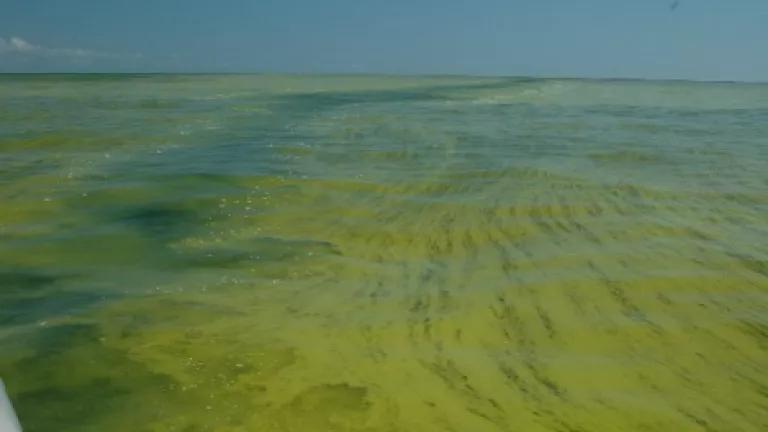
Credit: Ohio DNR, https://creativecommons.org/licenses/by-nc/2.0/
Poor Toledo. Could never happen here in California, right?
Wrong. The toxic blue-green algae that poisoned Toledo’s water supply last week and kept residents from using tap water for drinking, cooking, or washing has landed in California and is increasingly threatening waterbodies around the state, including the San Francisco Bay-Delta. And, instead of addressing the problem, state regulators are proposing steps that may make it worse.
Blue-green algae, or microcystis auruginosa, is a cyanobacterium that has bloomed in the Delta since 1999, and proliferated “dramatically” during the 2000s (a time when freshwater exports out of the Delta reached historically high levels). The toxins released from the algae blooms can cause liver damage, cancer, vomiting, severe headaches, and fever when ingested, and rashes, hives and blisters on exposed skin. According to CalEPA, there have been no known human deaths from microcystin, but it has killed pets and wildlife. It is also both a symptom and a potential contributing cause to the decline of the Delta’s ecosystem and the crash of many of its native fish species during the same time period.
This year, a microcystis bloom in the lower San Joaquin River is particularly bad because the algae thrives in warm water and low flows. As an environmental scientist with the Department of Water Resources explains in this article, "We're seeing extremely low flows [due to the drought], and that's really what makes it abundant."
The growth of microcystis in the Bay-Delta is worrisome for many reasons, including the fact that several of the blooms have occurred in the central and south Delta, near the massive state and federal water project pumps that export water to farms and communities south of the Delta. Together, these water projects deliver some portion of drinking water supplies to an estimated 25 million Californians.
So what are regulators doing to prevent these harmful blooms that are threatening the drinking water quality of millions of Californians, the health of the Delta, and recreation in the estuary? One important protection is included in the biological opinions for threatened and endangered fish that call for increased flows through the Delta, flows which help reduce the spread of microcystis. As the Ninth Circuit Court of Appeals recently explained when upholding protections for delta smelt in the U.S. Fish and Wildlife Service’s 2008 biological opinion:
The BiOp found that a “multitude of factors . . . affect delta smelt population dynamics including predation, contaminants, introduced species, entrainment, habitat suitability, food supply, aquatic macrophytes, and microcystis.” BiOp at 202. It concluded that “[t]he extent to which these factors adversely affect delta smelt is related to hydrodynamic conditions in the Delta, which in turn are controlled to a large extent by CVP and SWP operations.” BiOp at 202. … As the BiOp also discusses, CVP/SWP operations are likely to increase the harmful impact of microcystis on delta smelt because “[l]ow flow conditions are among the factors associated with Microcystis blooms.” BiOp at 372.
As the Fish & Wildlife Service found, and the court upheld, the higher flows required by the BiOp to protect imperiled fish populations are likely to help reduce the threat of microcystis.
But more recent proposals from the Department of Water Resources may worsen microcystis blooms in the Delta. One of the most controversial aspects of DWR's proposed Bay Delta Conservation Plan (BDCP) is the failure of the proposed plan to increase flows through the Delta, and, instead, divert even more freshwater away from the imperiled estuary, contrary to the recommendations of the scientific community. A recent independent science review of the proposed BDCP plan recognizes that this approach could worsen the microcystis threat in the Delta:
- “The fate of Microcystis aeruginosa is also not promising. Between trends in climate warming and planned water withdrawals, the prospects for Microcystis blooms appear to remain unchanged or slightly worse under the Plan, although the direction of these potential outcomes is highly uncertain.” (page 17)
- “Lehman et al. (2013) suggested that increased residence and warmer water temperatures in excess of 19 - 20° C will promote toxigenic cyanobacteria including Microcystis aeruginosa. It should be recognized that Microcystis is only one potentially important toxigenic cyanobacteria in the Bay-Delta – Aphanizomenon was abundant in 2011 and 2012 in the Bay-Delta (Karobe et al. 2013).” (page 34)
- “Key issues include ... more favorable conditions for Mycrocystis and harmful algal blooms, and continuous effort needed to control invasive aquatic vegetation and predator abundances.” (page 68)
- “Actions that increase water velocity and turbidity are helpful in controlling Microcystis blooms. ESO_ELT and LOS_ELT scenarios are projected to increase average water residence time (Table 5.F.8-2), which would have a detrimental effect in trying to control Myrcocystis. Submerged aquatic vegetation (SAV) control may produce water conditions unfavorable to Microcystis. Climate warming may be a significant driver in Microcystis trends in the future.” (page 70)
DWR's approach in the proposed BDCP is the wrong direction for the State – threatening not only the continued existence of several populations of native fish, but also potentially threatening the drinking water supply for millions of Californians. The decline of our native species often functions as a warning bell that we’re disrupting natural systems to the point where they will no longer meet human needs either. It’s time to heed the warning.
